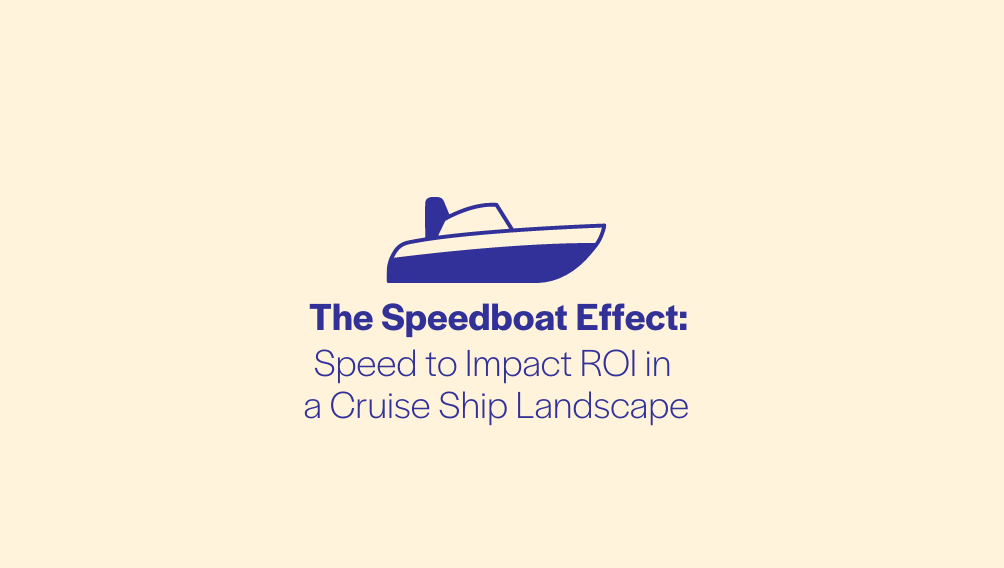The Speedboat Effect: Speed to Impact ROI in a Cruise Ship Landscape

Utilizing an enterprise EHR system is like traveling on a cruise ship. You and hundreds of fellow passengers are on the same journey, for better or worse. The ship is designed to keep everyone onboard happy. You know which destinations lie ahead, but the schedule may be impacted due to weather.
But what if you want to stay a little longer in one port? What if you need to hurry up and meet friends at a different destination? What if you’re a little seasick and want to slow down? You’re out of luck. There’s no diverting the cruise ship from its set route, even when passengers aren’t on board.
We often observe this in healthcare. Many complex organizations benefit from the immense scope and scale of an enterprise EHR to care for a broad patient population, but one size does not fit all. Patient experience and engagement varies widely. Healthcare is a competitive market. In many regions, patients have a choice about where to seek care. Without IT tools in place to smooth the patient journey, this looks like:
- Missed opportunities stemming from minimal patient portal adoption
- Lost revenue from no-show rates
- Stretched staff manually handling custom workflows in business line silos
Patients’ unique needs would benefit from speedboat flexibility to react to market conditions as they change. Enter patient engagement platforms: a solution that natively integrates with your EHR can implement new outreach strategies and realize results now.
In competitive marketplaces, this is not a luxury but a necessity. If you don’t have the ability to reach patients now, you risk losing them to a facility that can. How do we know? Because 87% of surveyed healthcare decision-makers agree that ability to compete in a marketplace is a driver for implementing patient engagement solutions (source). Fortunately, you don’t have to lag behind.
Fill the Cracks, Fast
What if your organization could start seeing changes in a matter of weeks?
Most systems are designed to work when everything is going right: when patients are fully engaged with all of their tools. In an enterprise health system, the multitude of available tools can flow through a patient portal for a streamlined patient experience. But data shows that more than half of patients aren’t using patient portals, even after receiving opportunities to register.
A platform approach to patient engagement can integrate into the native EHR and bridge some of the cracks with a medium that everyone uses: SMS text messaging.
Unlike enterprise EHR modules, API-integrated platform solutions can be implemented and launched within 45 days – enabling your organization to not just keep up with the Joneses, but surpass their assets.
Break Free from Boilerplate
Why are 89% of patients between the ages of 17-74 reluctant to use online scheduling options? Reasons include lack of access to internet, lack of awareness that options exist, low computer skills, and resistance to changing habits (source). It can be challenging to change their ways when limited to boilerplate messaging options and a set number of scenarios. To activate these patients and keep them within a healthcare network, organizations must be able to think outside the box – and step outside of boxes, too.
Partnership with a flexible patient success platform keeps patients on that journey. Over 1,000 messaging scenarios, and the ability to develop more, will accommodate your unique organization – and your patients – right from implementation.
Don’t Despair: Automate
When complexity abounds, organizations hesitate to adopt patient engagement technologies because their processes can vary wildly across the system. Specialities following different workflows keeps organizational knowledge siloed and ensures that valuable staff time is required to keep patients in-network. Many are surprised to learn that complexity doesn’t have to be a barrier to modernization. In fact, implementation of a platform is often an opportunity to simplify workflows and identify streamlined ways to automate tired processes. Administrators and staff alike are often pleasantly surprised to learn that people don’t have to manually undertake every step of the scheduling and intake processes.
The perfect mix
Automation is a hot topic right now, but it’s important to deploy a strategy that keeps humans involved when necessary. Sometimes it’s best to simplify the easy stuff and leave the personal touch for when it’s needed most. Main Line Health saved 15,000 minutes of human time per month when they implemented Digital Call Deflection. Inbound calls could be diverted to conversational SMS text messaging, enabling the call center to focus on patient interactions that benefited from a human touch.
What next?
Learn how an out-of-box solution can reach and activate the 40% of patients who aren’t using your organization’s patient portal. Request a demo here.